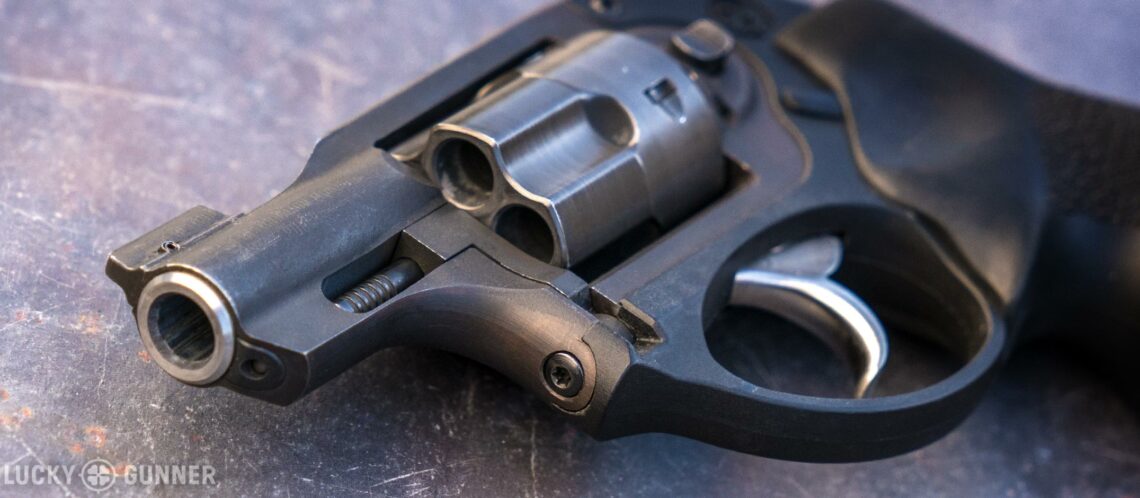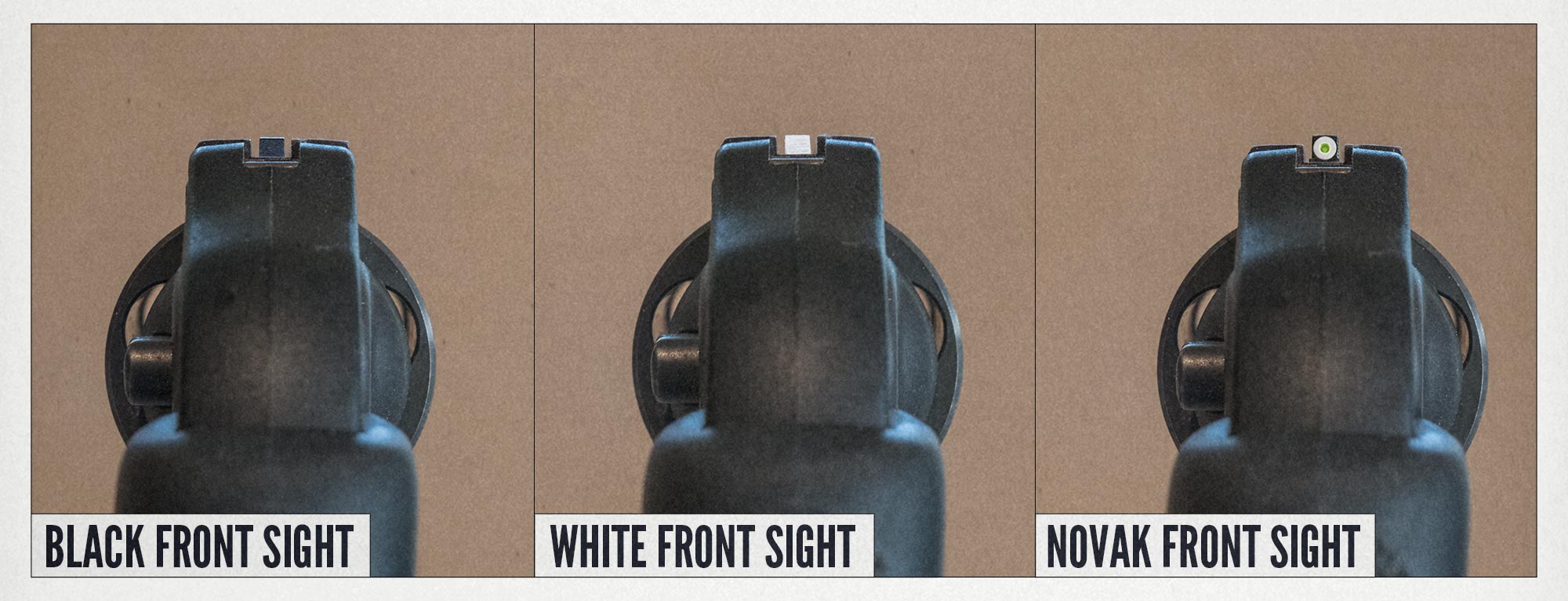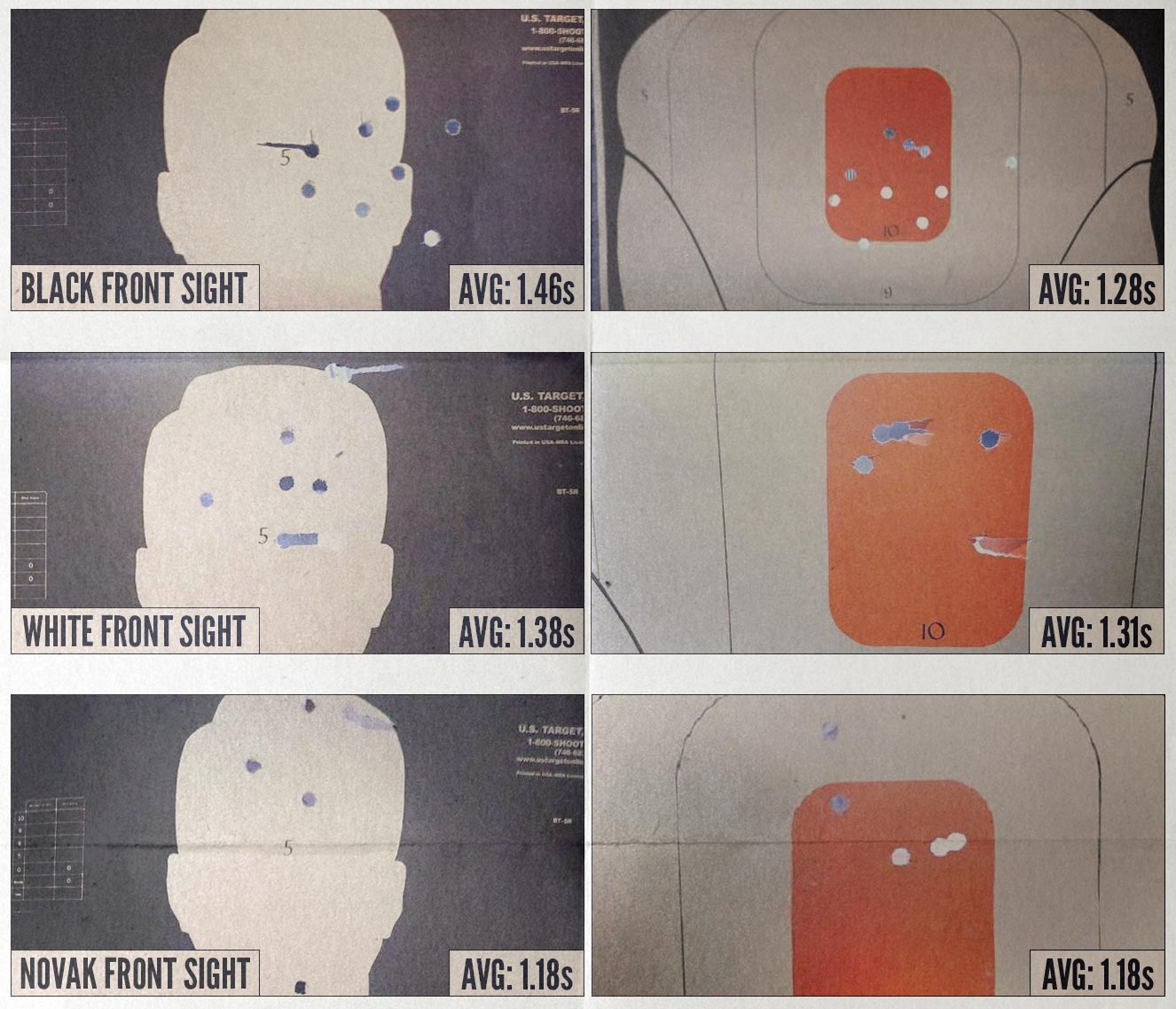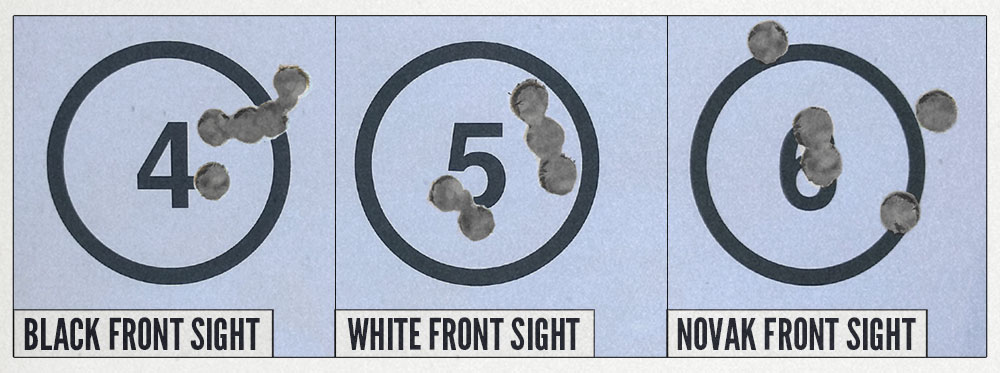In my last article, I addressed the myth that it’s impossible to use your sights under the stress of a violent encounter. That discussion was primarily focused on the “software” side of the equation — if we train to use our sights appropriately in practice, we can rely on those well-honed habits under stress as well. I also briefly touched on the hardware side of the issue. The more visible your sights, the more useful they are likely to be in a real encounter.
This argument for modern, highly visible sights often meets resistance when it comes to the snub nose revolver. More so than any other type of handgun manufactured today, snubby revolvers are frequently equipped with diminutive sights that can be difficult to see under a variety of lighting conditions. However, considering the short sight radius and the inherent challenge of shooting these guns accurately, would altering the sights really make any worthwhile difference? I wasn’t sure myself and thought it was worth testing with a simple experiment. As the Mythbusters taught us, the only difference between science and screwing around is writing it down, so I set out to test various sights, armed with a set of targets, a timer, and a notepad.
The LCR Front Sight Experiment
I chose to use the Ruger LCR revolver for the experiment. Small frame revolvers like the LCR and the Smith & Wesson J-frames are common everyday carry guns. Additionally, the front sight of the LCR is easy to change with nothing but a punch and small hammer, making it an ideal platform for a test comparing multiple front sights. The LCR has a fixed trench-style rear sight so I did not have to worry about lining up new sights or changing the style of the rear to match the front.
I decided to first test the factory black ramp front sight as the control. Following that, I would test a low dollar change to the front sight, followed by a more expensive change. I purchased two bottles of nail polish — one white and one green — at a dollar store for a grand total of $2. With the low cost and the ease with which the polish can be applied and removed, it is simple to try various colors to find out what works for your eyes. For the more expensive option, I purchased a $50 Novak “Mega Dot Tritium” front sight. I was able to install it in about two minutes with a 1/16-inch punch and hammer, so neither option is labor intensive.
It was quickly apparent that the Novak’s white insert surrounded by black was easier to pick up against a host of different colors and in various lighting conditions. Either the black or the white was always contrasted against the background, whereas each of the single color options had some condition in which they were difficult to see. I also discovered the green was much too glossy and reflected light in a distracting manner. I could tell right away that this particular green was unsuitable for me, so I did not test it further.
To determine if there was any real difference between the remaining three options, I would need to try them out at the range. In order to provide as accurate a comparison as I could, I shot each set of sights “cold” (with no prior warm-up shots) with two weeks in between each session. I fired from the same lane at the same indoor range under the same lighting.
For lighting conditions, I did my best to simulate a lit parking lot at night. I had most of the overhead lights off and the light source was up and to my right, as though from an overhead security light. The result was lighting conditions very similar to those where defensive pistol use often occurs. I also know that with plain black sights, I tend to bias my shots a bit toward the light source under these conditions and I wanted to see if I could improve that.
Timed Test Results
For the timed testing, I timed my press-out (gun in strong hand by rib cage, ready to press out to meet the support hand as it is extended toward the target) rather than my full draw stroke in order to eliminate variables in the draw and to show that any differences were strictly the speed at which I could acquire the front sight.
All shooting was done with 148 grain lead wadcutters from a distance of 7 yards on a silhouette style target. With each sight, I attempted both head shots and body shots. Only hits inside the head area and the center scoring zone of the body were counted toward the average time for each sight.
Black Front Sight
Head shot average: 1.45 seconds
Body shot average: 1.28 seconds
Observations: My shots were biased right (toward the light source) with the white background of the head, but not with the orange background in the center of the body. Further experimenting showed that acquiring a sight picture on a black background was difficult.
White Front Sight
Head shot average: 1.38 seconds
Body shot average: 1.31 seconds
Observations: My first two shots were high and barely touch the head. My eyes quickly adjusted to the new sight picture, though, and then I was marginally faster compared to using the black sights. I also did not have the problem of biasing toward the right with the white background. There was no substantial difference with the orange background.
Novak Mega Dot Front Sight
Head shot average: 1.18 seconds
Body shot average: 1.18 seconds
Observations: The Novak Mega Dot changes the sight picture away from the traditional “equal height/equal light” where the front sight is centered and the top of the front sight post is even with the top of the rear sights (explained in detail below). Once I got used to this, I did find the sights quick and intuitive to use, and they worked equally well against multiple colors.
Sights vs. Point Shooting
I also did a quick experiment to find out how unsighted fire, or “point shooting,” would compare to the various sight options for the LCR. When I spoke to the acclaimed competitive shooter Gabe White for my previous article, he pointed out that there is typically little to no time difference when comparing sighted versus unsighted fire at close range, but accuracy will drastically improve when the sights are used. To test this theory, I ignored the sights while using a target focus (eyes focused on the intended point of impact) and attempted the same press-out to head shot at seven yards as I had tested with sighted fire. I aimed solely by indexing the revolver.
My average time was 1.37 seconds, which was marginally faster than the black sight, about same as the white sight, and slower than Novak sight. However, my accuracy suffered while using this technique and I only hit the target an average of three out of every five shots.
This was right in line with Gabe’s observations. Particularly with easy to acquire sights, I am both faster and more accurate. I’ve continued to practice with the Novak Mega Dot sights since the LCR is my personal backup gun. I’ve been able to reach a 1.07 second average time to hit on the press-out to headshot drill as I’ve gotten used to the new sight picture.
Accuracy Testing
Following each of the “cold” timed tests above, I used 2-inch circle targets at seven yards to see if any of the sights offered an accuracy advantage. These were shot in the same low light conditions, but without any time pressure and after I had figured out the sight picture from the “cold” tests.
Precision shooting showed the same biases as the timed shooting. While the black sight grouped well, my shots veered toward the right. The white sight was very easy to shoot precisely and was well centered. The Novak was a bit more challenging, but still very acceptable.
Point of Impact Testing
Based on the above testing, I elected to stay with the Novak sight. The final step was to confirm that my normal carry ammunition would shoot to point of aim with the new sight installed. Using Winchester PDX1 Defender .38 Special +P, I fired another cylinder at one of the 2-inch circles and got a nice group right in the center. Snubby revolvers are particularly prone to point of impact changes when switching from one load to another, so it’s always important to test your defensive load to verify that it will make hits in the same spot you aim your sights. If the sights are not adjustable (and most are not) you may have to change to a different load to get the point of aim and point of impact to agree.
As touched on earlier, the Novak Mega Dot is larger and taller than the OEM front sight and does require a modified sight picture. For precise shot placement, the center of the front sight dot must be horizontally aligned with the top of the rear sights as shown in the sight comparison graphic above. The bottom of the dot sits on the bottom of the rear sight notch. This will cover your intended point of impact, making longer distance precision shots more challenging, but it works very well for closer distances. This is less complicated than it sounds and is very intuitive because when the sights are properly aligned, you can see the entire white circle, but not the top of the barrel.
At distances of 15 yards and less, the Novak Mega Dot is a pure upgrade for me. I can acquire the sight faster than the OEM black front sight and with no loss of accuracy, resulting in a faster time to first shot. I can also track the sight easier, making multiple shot strings less challenging.
Extended Range with the Snub Nose
Some simple experimentation confirmed that improvements to the sights on a snub nose can make quick and accurate hits easier at close range. The trade-off comes with longer distance shooting. You will frequently hear from the purveyors of gun shop lore that snubby revolvers are “belly guns” and “aren’t accurate past bad breath distances.” This is quite simply false.
Snubbies are not inherently less accurate than revolvers with a longer sight radius (the distance between the front and rear sights), but they do require more skill to employ at longer ranges. Small misalignment of the sights increases the angle much more with the short sight radius of a snubby than they do with a full-size 4-inch revolver, so you must be more precise when centering the sight. The shorter barrel also means reduced velocity, which leads to greater bullet drop. While that’s seldom a concern in realistic self-defense shooting distances, it does come into play at longer ranges.
With enough practice and proper technique, the snubby can be quite accurate at even extreme distances, as demonstrated by Jerry Miculek.
Now, most of us will never master the revolver in the way Mr. Miculek has, but with proper training, it can be surprisingly easy to hit a torso sized target at ranges far beyond what is typically considered feasible with a short barrel. For example, Sand Burr Gun Ranch’s “Snubbie Class,” taught by Dennis Reichard, routinely starts with average shooters and by the end of the day has them hitting half-size IDPA targets at 75 yards with 50% or greater accuracy.
In the case of my LCR, the Novak sight will make such long-range shooting more difficult. As the front sight covers more and more of the target, it can be challenging to maintain acceptable accuracy. As of this writing, I have tested back to 25 yards and have been able to maintain 100% accuracy in the 9-ring of the same silhouette-style targets I used for the timed tests. Given the ratio of defensive shootings that occur within seven yards as opposed to those that occur over 25 yards, I find this trade-off to be reasonable in the intended role of a snub nose revolver.
The Final Verdict
I believe the Novak upgrade is worth the cost and small amount of labor to install. If you can drive a nail, you can do this install yourself. The difference in low light was, pardon the expression, night and day. While the other sights did seem to really “pop” with certain backgrounds, they virtually disappeared with others. The Novak was readily acquired regardless of the background color. There is no change to the fit any of my holsters, although of course, you should verify this with your own holster any time you change the size of your front sight.
High visibility front sights like the Novak Mega Dot are not available as an option for all snub nose revolvers. For instance, the most popular of the Smith & Wesson J-frame revolvers are equipped with an integral front sight that cannot be changed by the user. However, you still have the option to try different colors of paint and other simple modifications in order to improve the visibility of these sights. Don’t be afraid to experiment a bit and see what works best with your vision. Break out those timers and targets and tell us what you find!




Sadly, some snubs (and other guns) don’t have upgradeable sights like the LCR. For these, I use either high visibility paint, or I glue a piece of reflective tape on my front sight. Just like the article you linked to 😉 works very well.
Wanted to add a word in on sighted vs. “point shooting”, I read “bullseyes don’t shoot back” by Mike Janich, it had some good info on the subject in it, and the thing that stuck with me the most was the idea of it being a “continuum” from extreme close range shooting without sights to distance work, of course with the sights. I guess its all about using the appropriate technique for the task at hand.
Nice, thanks.
Have an XS Tritium standard dot (seems about the same as the Novak) on my 357 LCR plus the Laser Max laser. This makes a great set up for any light condition. The LCR has to be the best CC snub nose ever. Even full power 357’s are fun, but I carry 38+P’s. On our 3″ & snub nose SP101’s I went with bright white appliance paint, worked great. Black front sights don’t work for us.
FWIW: The “International Long Range Pistol Shooters Association” in the UK used to have a Long Range Pocket Pistol division. This had stages at 100 and 200 yards. The rules originally allowed barrels up to 3.5 inches, but this was apparently reduced to 2 inches for revolvers at a later date. However, the rules provided quite a bit of leeway in other modifications. This resulted in the creation of monstrosities such as the modified Colt New Service seen below.
https://uploads.disquscdn.com/images/95e8c5de3d63ca35a0041706bc1ac5b7044a260188b0046e9607a4e6832d4c26.png
The United States Revolver Association (USRA) used to have Pocket Pistol events, but it allowed for barrels up to 4 inches. This was later extended to 4.5 inches to allow for the use of handguns like the Colt M1903 Pocket Hammer. They did at least restrict the overall weight to 32 ounces with a minimum caliber of .32, and the sights had to be rounded so they would not “interfere with quick drawing.” Match O required five shots on a target at 20 yards in 30 seconds. This was repeated until 25 shots were fired. Match F required five shots on a target at 50 yards in 30 seconds. Again, this was repeated until 25 shots were fired.
A bottle of Traffic Cone Orange nail polish has been my front sight marker for my carry pistols, and I find that I acquire the front sight much quicker with it than the white dot.
Just my 2 cents..
Go the extra money and get some Crimson Trace or other laser sight and just put the dot where you want to hit. It works great for me low light ,left or right hand. You can also shoot from just about any position without bring the gun up to your line of sight.
I heard the CT grips are to hard, making the shooting more painful, What are your thoughts? Do you use +P ammo?
I use a j frame, and my Crimson Trace is the Plastic boot grips. I prefer them. I’ve had them on for 9 years, and I think they are the cats meow.
The newer ones are made of rubber, which I don’t like because they are not as slick in the pocket. So when pocket carrying, I prefer the plastic grips as they come out of the pocket much faster.
Just bought the LCR in .38 Special. Great gun! I need to buy wadcutters for target practice because your hand gets beat up with the normal ammo. Great article!
If my little snubby has to come out at all, having proper sight will most likely be a luxury I won’t have. Being a small, up and close, last ditch, DA belly gun is what they excel at. Aim it and shoot.
A no nonsense approach would utilize a Charter Arms Boomer with laser grips. Point, illuminate, squeeze, inflate, and deflate.
I’ve shot .44 SPL, .38 SPL, .357 MAG, 9 LUGER and .22s out of short barreled revolvers. Practicing is much more fun if you shoot them using vibration dampening gloves.
https://uploads.disquscdn.com/images/58cd100abf3b40e1f685edbcb8daea6c139fa4181544b5a9f55b86297699efbe.jpg
I see fiber optic sights for the LCR, I wonder how those would be??
I have a HiViz fiber optic front sight on my LCR. I like it, but it does require the same unconventional sight picture as the Novak front sight in the article.
How can you do all this research and then conclude Novak sights are better when both you target experiments show tighter groupings occurred with white sights????